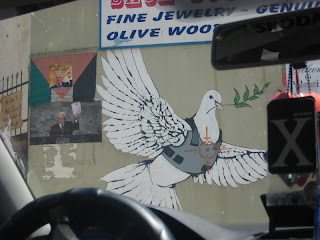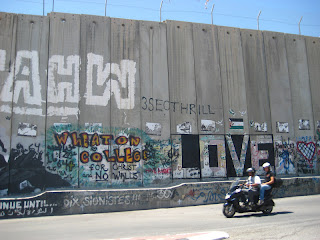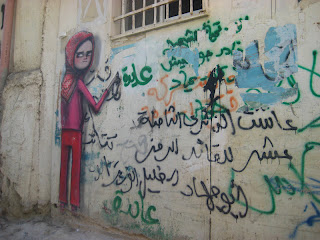I just got back from a day trip to Bethlehem and Hebron in the West Bank. As in March, I felt some distance from the holy sites due to the overwhelming hustle-bustle quality of it all and great heartache from witnessing the effects of the settlers' occupation of the West Bank.
Bethlehem
We met Al'a when we arrived at the Bethlehem bus station, who ended up becoming our driver and guide for the day. It was an incredible deal -- he was with us from 1:00-7:30 for 300 nis. And he was so accommodating and nice. We visited the Church of the Nativity and Manger Square:
More graffiti along the wall:
Aida refugee camp
Al'a also drove us through the Aida refugee camp. We didn't have tea with any families this time, but he told us various stories about the residents' way of life and the shootings by Israeli soldiers. I felt that it would be inappropriate to take photos of people's homes, especially when there were children running around, so I just took photos of bullet holes that Al'ia pointed out to us and the art:
Hebron
I hope you've made it this far down the post, since Hebron continues to be an incredibly powerful place for me to visit. My heart thumps as I feel the tension in the air and get to make more Palestinian friends. The thumping settles into a melancholy state as I hear about and see the ways in which Palestinian residents are treated by the Israeli settlers. In March, we met with volunteers for the Ecumenical Accompaniment Program in Palestine and Israel (EAPPI), who told us about how they have to walk Palestinian children to school because they otherwise get rocks thrown at them by the Israeli kids. Rocks, in addition to trash and urine, get thrown down from the settlers' homes above to the Palestinian souk below:
(the following two photos are from Sara)
Bethlehem
We met Al'a when we arrived at the Bethlehem bus station, who ended up becoming our driver and guide for the day. It was an incredible deal -- he was with us from 1:00-7:30 for 300 nis. And he was so accommodating and nice. We visited the Church of the Nativity and Manger Square:
(throwback: view of Bethlehem from my hotel window one early morning in March)
(Manger Square, opposite the Church of the Nativity, today)
(Very recent addition to the UNESCO's World Heritage List, with controversy: "Last year, Unesco became the first UN body to officially accept Palestine as a member state, despite strong opposition from the US and Israel, which said it would further remove the possibility of a permanent peace deal.")
(Nick, me, and Sara in front of the Church)
(The Door of Humility, "a remnant of Christian attempts to prevent Muslims from entering on horseback" (Let's Go Israel))
(you can peek in to see these mosaic floors in the large room leading to...)
(the Greek Orthodox section of the Church)
(in the corner is the Armenian section, which I couldn't take a decent photo of since there were so many people crowded in it... I'll try to get a friend's photo and include it here later)
(St. Catherine's Church, the Catholic section)
Down the stairs is a series of crypt rooms. There is the Chapel of St. Joseph, the Chapel of the Innocents (burial cave of children killed under King Herod's orders in Matt. 2:16), and the Grotto of the Nativity. The way is blocked by a door with a peephole. "During times of greater hostility between Christian sects, this glimpse was as close as Catholics could get to the Greek Orthodox shrine"( Let's Go Israel).
(the peephole)
(paintings in the chapels)
(touching the 14-pointed star (each point representing a station on the Via Dolorosa) that traditionally represents the place of Jesus' birth, at the Grotto of the Nativity)
"The star, added by the Catholics in 1717, was removed by Greeks in 1847 and restored by the Ottoman government in 1853. Quarrels over the star are said to have contributed to the outbreak of the Crimean War.
In 2002, the IDF invaded Bethlehem and 200 Palestinian militants fled to the church of the nativity, where they holed up with monks and civilians who had been trapped in the church. The ensuing siege and negotiations lasted 39 days, after which Israel agreed to deport the militants in exchange for release of the civilians. Many of the fighters were sent to Jordan and the Gaza Strip; the most wanted were moved to Italy and Spain." (Let's Go Israel)
(place of the Three Magi in the Grotto)
Graffiti
Al'a was kind enough to take us along the wall and point out the Banksy pieces, and even take us to the Banksy store where the graffiti artist buys his spray paint. Across the from the store is the famous girl with the balloons.
(Banksy's girl checking a soldier)
(the girl with balloons)
(the Banksy store... in the center is a print of a soldier checking a donkey's permit. It was our guide's favorite, since it resonates with his frustration with the checkpoints.)
(Banksy's dove target)
More graffiti along the wall:
(!)
Al'a also drove us through the Aida refugee camp. We didn't have tea with any families this time, but he told us various stories about the residents' way of life and the shootings by Israeli soldiers. I felt that it would be inappropriate to take photos of people's homes, especially when there were children running around, so I just took photos of bullet holes that Al'ia pointed out to us and the art:
(this is a girl who's been in an Israeli prison since the age of 16 under suspicion of being a terrorist)
(bullet holes in the doorway to a UN building)
(started with 610, now over 4,700 registered refugees according to the UNRWA)
(the names of their hometowns)
And an uncomfortable contrast nearby: the Intercontinental Hotel, where rooms are $300/night.
Herodion
Al'a drove us across the stunning landscape (Kidrom Valley, "Valley of Fire," the site of Moloch worship in biblical times, the site of the suicide of Judas Iscariot) to get to the Herodion, which was built as King Herod's summer palace and later used by the rebels in the Bar Kokhba revolt, who used the fortress in ~132CE.
(some of the landscape along the way)
(looking into the Herodion from the top)
(looking out at the view)
(you can see the Judean Desert and Dead Sea from the top)
(Herodion living quarters from 1st century BCE)
(the central Herodion cistern... pretty huge)
(incredible tunnel system, that is hard to capture in photos...)
Hebron
I hope you've made it this far down the post, since Hebron continues to be an incredibly powerful place for me to visit. My heart thumps as I feel the tension in the air and get to make more Palestinian friends. The thumping settles into a melancholy state as I hear about and see the ways in which Palestinian residents are treated by the Israeli settlers. In March, we met with volunteers for the Ecumenical Accompaniment Program in Palestine and Israel (EAPPI), who told us about how they have to walk Palestinian children to school because they otherwise get rocks thrown at them by the Israeli kids. Rocks, in addition to trash and urine, get thrown down from the settlers' homes above to the Palestinian souk below:
(the following two photos are from Sara)
(the Palestinians needed to put a fence above their souk/market in order to protect themselves from the trash thrown at them from the settlers' residences above)
(I bought a cushion cover from a man whose family has owned his shop in the souk for generations. He stitches old Palestinian wedding gowns together to make patchwork items--quite lovely. Settlers threw eggs down into his shop, hitting many of his hanging items, like the scarf above.)
(the Ibrahimi Mosque, which holds the traditional tombs of Abraham, Sarah, Isaac, and Rebekah; since it was shabbat, the Jewish half was closed of course)
(the walls were made of 8m-long slabs of stone!)
(Israeli soldiers checking all along the way)
(interior)
(Abraham's tomb)
(Al'a told us that these 3,000+ wooden pieces are put together without any kind of adhesive or nails--he could jiggle the pieces around)
We concluded our full day with heavy hearts, a good Palestinian meal with beer, and great continued conversation with Al'a. In the car, he had shown us photos of his two boys, his lovely and tall wife, and videos of him making many kilos of shwarma at his father's restaurant.
































































No comments:
Post a Comment